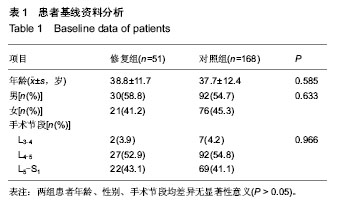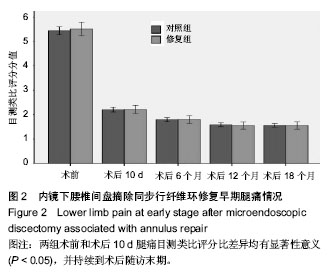| [1] 胡有谷.正确对待腰椎间盘突出症手术疗效的评价[J].中华骨科杂志,2003,23(9):516-517.
[2] 胡有谷.腰椎间盘突出症[M].第2版.北京:人民卫生出版社,1985.
[3] 陈小路,彭昊.椎间盘镜治疗腰椎间盘突出症177例的临床疗效分析[J].临床外科杂志,2008,16(10):696-697.
[4] Ambrossi GL, McGirt MJ, Sciubba DM, et al. Recurrent lumbar disc herniation after single-level lumbar discectomy: Incidence and health care cost analysis. Neurosurgery. 2009; 65:574-578 .
[5] Carragee EJ, Spinnickie AO, Alamin TF, et al. A prospective controlled study of limited versus subtotal posterior discectomy: short-term outcomes in patients with herniated lumbar intervertebral discs and large posterior anular defect. Spine. 2006;31:653-657.
[6] Barth M, Diepers M , Weiss C. Two-year outcome after lumbar microdiscectomy versus microscopic sequestrectomy. Part 2: radiographic evaluation and correlation with clinical outcome. Spine. 2008;33:273-279.
[7] McGirt MJ, Ambrossi GLG, Datoo G, et al. Recurrent disc herniation and long-term back pain after primary lumbar discectomy: review of outcomes reported for limited versus aggressive disc removal. Neurosurgery. 2009;64:338-345.
[8] Watters WC, McGirt MJ. An evidence-based review of the literature on the consequences of conservative versus aggressive discectomy for the treatment of primary disc herniation with radiculopathy. Spine J. 2009;9:240-257.
[9] Yasargil MG. Microsurgical operation of herniated lumbar disc. Adv Neurosurg. 1977;(4):81.
[10] Cauthen JC, Guyer RD, Zigler JE. Microsurgical anular reconstruction (anuloplasty) following lumbar microdiscectomy. Spinal Arthroplasty. 2005;156-177.
[11] Garg B, Nagraja UB, Jayaswal A. Microendoscopic versus open discectomy for lumbar disc herniation: a prospective randomised study. J Orthop Surg (Hong Kong). 2011;19(1):30-34.
[12] 张超,周跃,初同伟,等.椎间盘镜下与开放手术治疗腰椎间盘突出症对椎旁肌损伤程度的对比研究[J].中国骨与关节损伤杂志, 2006, 21(4):287-289.
[13] Bailey A, Araghi A, Blumenthal S, et al. Prospective, multicenter, randomized, controlled study of anular repair in lumbar discectomy: two-year follow-up. 2013;38(14):1161-1169.
[14] Pfirrmann CW, Metzdorf A, Zanetti M, et al. Magnetic resonance classification of lumbar intervertebral disc degeneration. Spine (Phila Pa 1976). 2001;26(17):1873-1878.
[15] Weishaupt D, Zanetti M, Boos N, et al. MR imaging and CT in osteoarthritis of the lumbar facet joints. Skeletal Radiol. 1999; 28(4):215-219.
[16] Goutallier D, Postel JM, Bernageau J, et al. Fatty muscle degeneration in cuff ruptures. Pre- and postoperative evaluation by CT scan. Clin Orthop Relat Res. 1994;(304):78-83.
[17] Fairbank JC, Pynsent PB. The Oswestry Disability Index. Spine. 2000;25(22):2940-2952.
[18] 叶建红,宁亚功.目测类比评分法在股骨头坏死疗效评价中的应用[J].中国现代医学杂志,2003,13(22):89-90.
[19] Arts MP, Kols NI, Onderwater SM, et al. Clinical outcome of instrumented fusion for the treatment of failed back surgery syndrome: a case series of 100 patients. Acta Neurochir (Wien). 2012;154(7):1213-217.
[20] Smith JW, Walmsley R. Experimental incision of the intervertebral disc.J Bone Joint Surg Br. 1951;33-B(4):612-625.
[21] Hampton D, Laros G, McCarron R, et al. Healing potential of the anulus fibrosus. Spine (Phila Pa 1976). 1989;14(4):398-401.
[22] Fandiño J, Botana C, Viladrich A, Gomez-Bueno J.Reoperation after lumbar disc surgery: results in 130 cases. Acta Neurochir (Wien). 1993;122(1-2):102-104.
[23] 杨洋,叶晓健,杨成伟,等.腰椎间盘纤维环切口不同修复方法的生物力学研究[J].中国脊柱脊髓杂志,2014,24(7):626-629.
[24] Ahlgren BD, Vasavada A, Brower RS, et al. Author informationAnular incision technique on the strength and multidirectional flexibility of the healing intervertebral disc. Spine. 1994;19(8):948-954.
[25] 张乐辉,赵易,李锦军.纤维环切口方式与椎间盘愈合强度的实验性研究[J].临床和实验医学杂志,2007,6(4):5-7.
[26] Ahlgren BD, Lui W, Herkowitz HN, et al. Effect of anular repair on the healing strength of the interverbral disc: a sheep model. Spine. 2000;25(17):2165-2170. |


